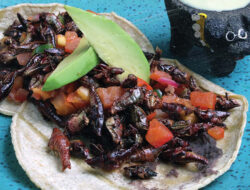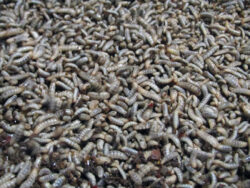
Features
Innovation
Top innovation story of 2023: Bugging out
By Jeff Tribe
Exploring the potential of insect feed for livestock
 Black soldier fly larvae are considered one of the leading insects for livestock feed.
Photo: Grant Vandenberg
Black soldier fly larvae are considered one of the leading insects for livestock feed.
Photo: Grant Vandenberg Mali Fernandez’s grasshopper tacos feature pan-fried crunchiness with salt, lime and spices enhancing hoppers’ natural ‘herbal’ flavour. A rare delicacy in Toronto, insects have provided a cheap protein source for ‘thousands of years’ in Mexico and remain street food and farmers’ market staples, says the owner and head chef of the trendy spot, Xola.
While some may still resist dining on insects – even if presented as theatrically as Fernandez’s dishes – many have watched the market for years and are viewing it as one with enormous if not virtually untapped potential.
And that’s just for humans.
Increasingly, insects are viewed as having potential as a livestock feed component. And with public perceptions around matters like the environment changing, there could be potential for insect feed to grow in popularity.
A ‘matter of when’
Attractions include a dependable domestic balanced protein source, reputed digestive tract and immunity advantages, environmental sustainability through waste conversion and greenhouse gas reduction, and frass, a soil-amendment by-product with potential anti-fungal properties.
“It’s not a matter of if, it’s a matter of when,” says Grant Vandenberg, professeur titulaire with Laval University’s faculty of agriculture and food sciences. “I am convinced with everything that is swirling around issues in feeding animals, there is no other option, honestly.”
While it might be a “matter of when,” it can be difficult to chart or predict the pace of growth, with regulations and social acceptability varying from country to country. As humans become open – slowly – to the idea of a little cricket “crunch” now and then, it’s difficult to know if livestock could follow at the same pace. Dutch entomologist Arnold van Huis says insects have historically boosted humans’ diets, particularly in temperate climates where supplies are larger and available year-round. But Western Europe’s edible insect industry is nascent, human consumption only recently approved. Between 20 and 25 per cent of citizens indicate a willing appetite, more so processed components of bread, sausages, burgers or energy bars.
“For most people, it’s preferable they don’t see them.”
Three species top the menu: mealworms (human consumption), crickets (human and pets) and Black Solider Fly larvae (poultry, fish and other animals). Currently, van Huis estimates insect protein comprises less than one per cent of western European livestock feed.
Half of that insect-based protein goes to pet food production, recognizing the sector’s price premium tolerance combined with reputed hypo-allergenic benefits. Roughly 25 per cent goes toward chicken feed and between 16 and 20, aquaculture. It’s expected that within a decade, economies of scale through industrial-level production and rising fish meal prices will see a majority of insects as fish food.
Higher price is a factor in insect-based protein. Van Huis estimates a tonne of soybean protein at 500 Euros, insect-based running between 1,000 and 1,500. However, the equation is not linear when factoring in related considerations.
Dietary advantages
Vandenberg, a leading (or arguably the leading) Canadian edible insect researcher, espouses the holistic advantages of Black Soldier Fly (BSF) larvae.
“They eat pretty much anything that is rotting, animals, plants, manure.”

Insect-based protein for humans, like Xola’s grasshopper tacos, are growing in popularity, albeit slowly.
Photos: Mali Fernandez, Grant Vandenberg
The diverse bio-digesters hatch four days after egg laying, harvestable as fully-grown larvae 10 to 14 days into their 35-day life cycle. They are then cleaned and converted into whole dried larvae, oil or defatted meal.
The appropriate pairing of BSF and 100 wet tonnes of organic waste results in 35 tonnes of larvae says Vadenberg, along with castings or frass.
Protein production removing waste organics from landfills is beneficial both in terms of cost savings says Vandenberg and because they decompose into methane, 30 times more potent as a greenhouse gas than CO2.
Beyond production with significant environmental advantages, insects are evolutionarily appropriate poultry and fish fare.
“It’s a very complete protein profile,” says Vandenberg, noting fish will literally jump out of the water to eat frozen BSF larvae.
Additionally, research has identified the potential for enhanced micro gut and immune system benefits, attributable to kaitin (outer insect shell).
“It is normally indigestible but stimulates the immune system,” says Vandenberg, adding study into the possibility it might help eliminate antibiotics in weaner pigs is currently underway. There are also indications feeding insect lipids to weaner pigs may have anti-bacterial activity.
Frass, “Insect poop, essentially,” Vandenberg smiles, is an organic soil amendment which also may perform anti-fungal activity against phytopathogens, for example, fusarium in wheat.
“The bottom line is value along the entire value chain.”
The Canadian Food Inspection Agency (CFIA) is a world leader in approving insect-based protein for animal feed, Vandenberg credits. Base material is currently limited to plant-based, pre-consumer waste. Applications are reviewed on an individual case-by-case basis.
“It’s not a generic approval.”
Like any other food or feed, insect-based protein is also subject to an array of federal and provincial regulations.
What production looks like (for now)
Industrial capacity will be required to move insect-based feed forward says Vandenberg, currently representing a tiny fraction of North American consumption.

Insect feed can be grown with a smaller footprint than grains, which some cite as an environmental advantage.
Barbara Campbell, regional director, Atlantic Canada with National Products Canada (NPC), a non-profit company promoting early-stage innovation, says there are currently three large insect-based protein companies in Canada, five mid-size and over 20 smaller entities.
Industry benchmarking indicates for BFS larvae, a 100,000-square-foot facility processing 100 tonnes of organic waste daily represents a ‘really viable business’ says Campbell. “And can reach cost parity with fish meal on a high day.”
She uses a comparative analogy between insects and a tennis court-sized field of corn. The insect ‘field’ features crops stacked 20 layers high, growing 24/7 regardless of climate, harvested every 10 days, including the cobs, husks, root ball and soil, all of which are up-cycled into saleable product.
“It’s exponentially more sustainable to produce protein this way.”
Progress is ongoing. Entosystem in Drummondville, Que. opened its 100,000-square-foot expansion this January (2023), while at full capacity, Aspire in London, Ont. will be the world’s largest cricket producer. Entomo Farms currently runs ’120-million head’ of crickets in three 20,000-square-foot retrofitted chicken barns near Peterborough, Ont. where they are fed fed four different grains, a vitamin mix and have constant access to fresh water. They are harvested around five-and-a-half weeks of age save for breeding stock bedded in peat moss. Eggs hatch in a few weeks.
The challenge lies in end users requiring a proven, consistent supply before committing, and producers needing a commitment prior to investment. End users can’t currently expect to fulfil large-scale demand with insect-based protein says Campbell. However, she adds that interested parties could consider research study participation.
“Collaborate and get involved,” she suggests. “It’s coming.”
Print this page